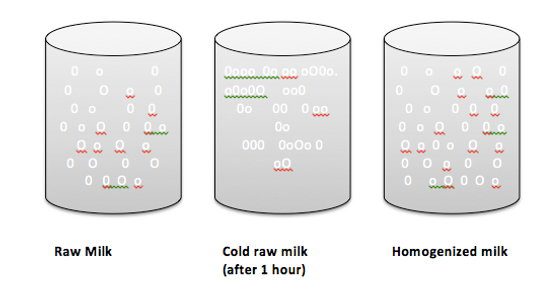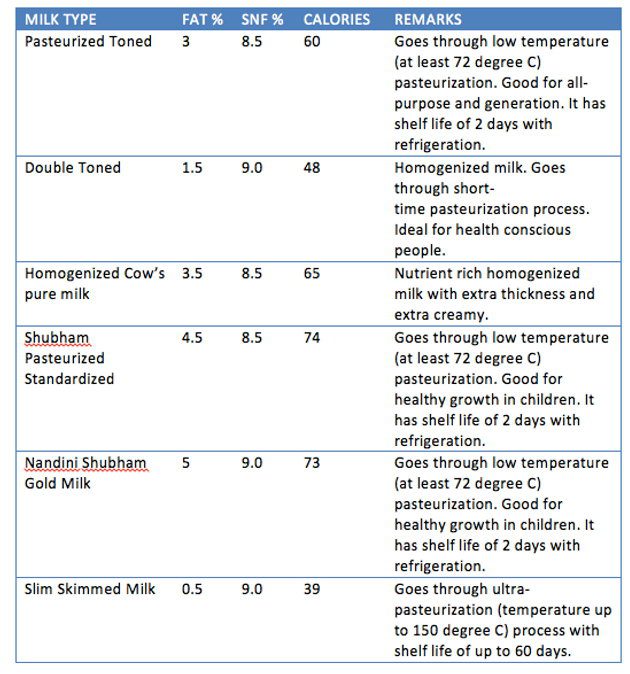Most of the parents convince their kids saying that "drink your milk quickly so that you'll grow big and strong!". Reason is: milk provides valuable macronutrients (Protein, Fat & Carbohydrates) as well as micronutrients (Vitamin A, C, D, B Vitamins, Calcium, Iron, Magnesium, Phosphorus, Potassium & Zinc) that kids need during their development.
There are so many benefits from drinking milk other than just “strong bones”. Let’s try to understand most common milk processing methods (pasteurisation and homogenisation) before getting into the detail of various milk variants:


The process of pasteurisation keeps the milk good for a longer period, but very high temperature harms its nutritive values. Most of the manufacturers use 3 methods for pasteurisation:
Low temperature pasteurisation: Milk is treated from 60 degree C to 150 degree C. Enzymes, and proteins remain intact up to this temperature & it is safe to consume this milk.
Medium temperature pasteurisation: Milk is treated up to 151 degree C – 170 degree C. At this temperature it kills enzymes and destroys proteins as well.
High temperature pasteurisation: Raw milk is treated up to 280 degree C. It kills many molecules and bacteria that can cause it to spoil more quickly. Unfortunately, killing harmful molecules, this process also kills the good probiotic bacteria and molecules, which help digestion and aid the immune system.
Homogenised milk is whole milk in which the fat is combined with the skim milk by a mechanical process. The purpose of homogenisation is to the break-up of the fat molecules in milk to such an extent that no visible cream separation occurs in the milk even after storage. Without homogenisation, the fat molecules eventually rise to the top and create a layer of cream.
The primary goal of homogenisation is to make sure that you have consistent tasting milk. It makes your milk homogeneous with an even amount of milk fat in each sip. Homogenised milk is considered safe and has not witnessed any adverse effect on health as such.

If you observe, 2 components are labeled on each milk packet:
It is amount of fat available in the packet, which is nothing but solid portion of milk. It carries fat-soluble vitamins A, D, E & K. If 1 cup of whole milk weights 250 gm and contains 8 gram of fat then Fat% = 8/250 * 100= 3.2%
Solid-Non-Fat (SNF) portion consists of protein (primarily casein), carbohydrates (primarily lactose), vitamins and minerals (which includes calcium and phosphorus).
Now, when we know about different processing methods and key components involved in milk, let’s try to understand which milk packet we should pick out of so many variants like full cream, single toned, double-toned, skim milk.
Looking at below six variants, it is very much clear that these variants are differentiated largely based on Fat% and processing conditions.
Before we decide which milk variant will suit kids & which one can be opted by adults, let's compare key nutrients (per 100 ml) of different variants of milk:

If we look at this table, Fat is the main nutrient, which is removed from milk to make it single toned, double-toned & skim milk. When low-fat and fat-free variants of milk are prepared, the cream from whole milk is skimmed out.
Unfortunately, removing the fat also removes the fat-soluble vitamins (D, A, E and K). As a result, reduced-fat varieties contain lower amounts of many nutrients. However, fortification process of milk ensures that lower-fat milk is nutritionally same as whole milk.
As Fat% reduces, overall calorie content also gets reduces. It means that it is not recommended for children under age 5-6 to give low-fat/skimmed milk, as they need additional calories for brain development as well as overall growth.
However, it is a good choice for adults who wish to control their calorie intake for weight loss etc. As skim milk is low in saturated fat, it is recommended in diseases such as heart disease and diabetes.
As milk contains lactose, therefore, lactose intolerant people should avoid milk and dairy products. Common symptoms, which usually occur within 30 minutes to 2 hours post milk or dairy products consumption are: bloating, nausea, abdominal pain, cramps.
Note: Nandini milk majorly supplied in Karnataka has been considered for different milk variants comparison.
If you have any questions regarding nutrition or weight management, please schedule an online appointment with Dt. Silky Mahajan for expert guidance.
Please send us an email at info@foodsandnutrition.in or call on 7829999400 between 10:00 AM IST - 7:00 PM IST (Mon - Sat).
